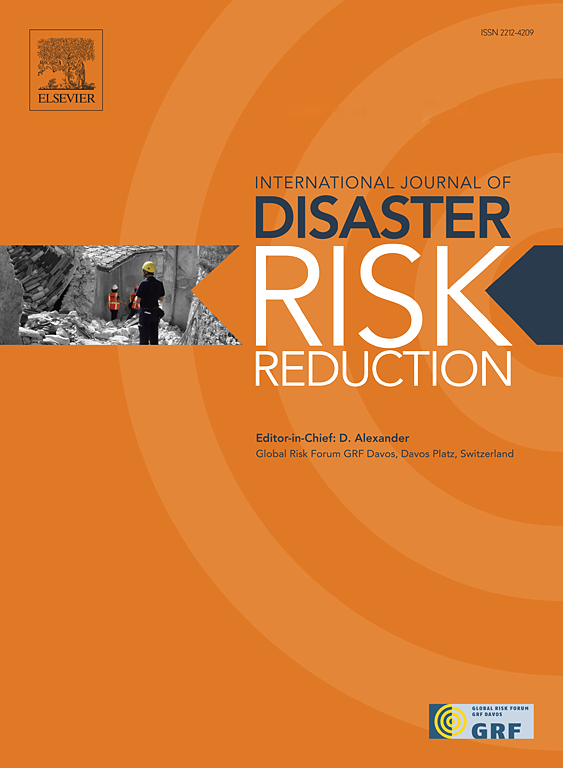考虑河床变形影响的路堤破坏生命损失定量评价
IF 4.5
1区 地球科学
Q1 GEOSCIENCES, MULTIDISCIPLINARY
International journal of disaster risk reduction
Pub Date : 2025-03-11
DOI:10.1016/j.ijdrr.2025.105390
引用次数: 0
摘要
剧烈的人类活动引起的河床剧烈变形会改变河流的水力学,从而影响河流的淹没。由于河道内的人类活动,北江发生了严重的下切,大大增加了其流量。本文分析了考虑河床变形影响的决口造成的洪水生命损失。建立水动力模型与路堤破坏模型相结合,模拟洪水,为不同情景下的死亡率评估提供依据。结果表明:最大淹没深度减小了约2 m,同时由于河床底切,洪水到达时间延迟。与1999年相比,2020年大部分地区的洪水死亡率下降了0.2左右。洪水水动力的变化对靠近决口区域的死亡率下降贡献超过80%,而远离决口的剩余区域的死亡率对洪水到达时间更为敏感。预警是减少洪涝灾害中生命损失的有效措施,提前12小时预警可使死亡率降低50%以上。研究结果可为评价河床演变对洪涝灾害风险的影响和减轻洪涝灾害损失提供参考。本文章由计算机程序翻译,如有差异,请以英文原文为准。
Quantitative evaluation of life loss induced by embankment failure with the impact of riverbed deformation
Drastic riverbed deformation caused by intensive human activities will change river hydraulics which may impact the fluvial inundation. The Beijiang River has undergone severe downward incisions due to in-channel human activities, greatly increasing its discharge capacity. This study analyzed flood loss of life induced by dike breaches considering the effects of riverbed deformation. The hydrodynamic model coupled with the embankment failure model was established to simulate floods and provide the basis for mortality evaluation under different scenarios. The results show that the maximum inundation depth decreased by approximately 2 m and the flood arrival time was also delayed due to riverbed undercutting. The flood mortality in most areas in 2020 has decreased by approximately 0.2 compared with that in 1999. The changes in flood hydrodynamics contributed over 80 % to the decline in mortality rate in the areas near the breach, while the mortality in the remaining zone that far away from the breach was more sensitive to the flood arrival time. Early warning is an effective measure to reduce loss of life during flood disasters, and a 12-h advance warning may reduce the mortality rate by more than 50 %. This study provides a reference for evaluating the impact of riverbed evolution on flood risk and mitigating losses of flood disasters.
求助全文
通过发布文献求助,成功后即可免费获取论文全文。
去求助
来源期刊

International journal of disaster risk reduction
GEOSCIENCES, MULTIDISCIPLINARYMETEOROLOGY-METEOROLOGY & ATMOSPHERIC SCIENCES
CiteScore
8.70
自引率
18.00%
发文量
688
审稿时长
79 days
期刊介绍:
The International Journal of Disaster Risk Reduction (IJDRR) is the journal for researchers, policymakers and practitioners across diverse disciplines: earth sciences and their implications; environmental sciences; engineering; urban studies; geography; and the social sciences. IJDRR publishes fundamental and applied research, critical reviews, policy papers and case studies with a particular focus on multi-disciplinary research that aims to reduce the impact of natural, technological, social and intentional disasters. IJDRR stimulates exchange of ideas and knowledge transfer on disaster research, mitigation, adaptation, prevention and risk reduction at all geographical scales: local, national and international.
Key topics:-
-multifaceted disaster and cascading disasters
-the development of disaster risk reduction strategies and techniques
-discussion and development of effective warning and educational systems for risk management at all levels
-disasters associated with climate change
-vulnerability analysis and vulnerability trends
-emerging risks
-resilience against disasters.
The journal particularly encourages papers that approach risk from a multi-disciplinary perspective.
 求助内容:
求助内容: 应助结果提醒方式:
应助结果提醒方式:


